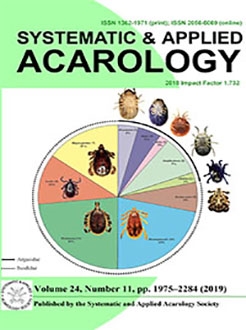Bats are well adapted to inhabit human settlements and are suitable reservoirs of a high number of vector-borne pathogens with veterinary-medical importance. Owing to these eco-epidemiological traits, the importance of studying bat ectoparasites is increasingly recognized. However, relevant molecular-phylogenetic data are missing from several countries of southern Asia, including Pakistan. In this study 11 ectoparasites, collected from bats in northern Pakistan, were analyzed morphologically and/or molecularly, phylogenetically from a taxonomic point of view. In addition, soft ticks were screened for pathogen DNA. Three mesostigmatid mite species were identified: Steatonyssus occidentalis evansiMicherdziński, 1980 and Ancystropus taprobanius Turk, 1950 from Rousettus leschenaultii (Desmarest 1820) and two specimens of Spinturnix americanus (Banks 1902) from Pipistrellus cf. javanicus (Gray 1838). Six soft tick (Carios vespertilionis Latreille, 1802) larvae were also removed from Scotophilus kuhlii Leach, 1821. Morphometric comparison revealed minor differences in comparison with C. vespertilionis larvae from Europe (i.e., narrower scutum and longer 4th posterolateral setae, while scutal length and shape index were not significantly different in this context). When molecularly analyzed, C. vespertilionis larvae from Pakistan showed the highest, 94.1% cox1 sequence identity with a sample from Kenya, while in their 16S rRNA gene these had the highest, 96.2–96.4% identity with samples from Europe and central Asia (northwestern China). These findings were confirmed in phylogenetic analyses. A further soft tick larva, collected from R. leschenaultii and therefore provisionally called Argas sp. “rousetti”, yielded sequences with only 86.2% and 91% similarities in its cox1 and 16S rRNA genes, respectively, to the genetically closest species, A. boueti. Both Argas species belonged to the phylogenetic group of the subgenus Chiropterargas. Molecular screening of two C. vespertilionis larvae for a broad range of tick-borne pathogens yielded negative results. However, the larva of Argas sp. “rousetti” showed the presence of a spotted fever group (SFG) Rickettsia sp., which (based on four genetic markers) was closely related to two Rickettsia species reported from southeastern Asia (i.e., R. honei and Rickettsia sp. IG-1), but differed more significantly from other rickettsiae. In conclusion, the three mite species identified here are new records for their host species and for Pakistan. The present findings support that despite the observed genetic differences, C. vespertilionis in southern Asia (Pakistan) and Europe belong to the same species and share common ancestry with C. vespertilionis in east Africa (Kenya). The soft tick species, Argas sp. “rousetti” is most likely a not yet described species within the subgenus ChiropterargasHoogstraal, 1955, because it was clearly separated from A. boueti Roubaud & Colas-Belcour, 1933 and A. confususHoogstraal, 1955 in the phylogenetic analysis (also taking into account that other known species of the subgenus are unlikely to occur in Pakistan). The novel Rickettsia genotype from Argas sp. “rousetti”, represents the first molecular identification of a Rickettsia sp. phylogenetically close to R. honei, and the first Rickettsia sp. from any bat-associated soft tick species in southern Asia.
How to translate text using browser tools
15 November 2019
A new Rickettsia honei-related genotype, two novel soft tick haplotypes and first records of three mite species associated with bats in Pakistan
Hamid Ullah,
Jenő Kontschán,
Nóra Takács,
Michiel Wijnveld,
Anna-Margarita Schötta,
Sándor A. Boldogh,
Attila D. Sándor,
Sándor Szekeres,
Tamás Görföl,
Syed Basit Rasheed,
Arshad Javid,
Sándor Hornok
ACCESS THE FULL ARTICLE
Argas
Chiroptera
Chiropterargas
Pteropodidae
Vespertilionidae





